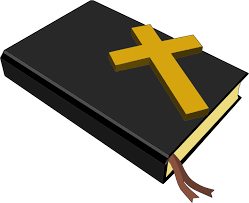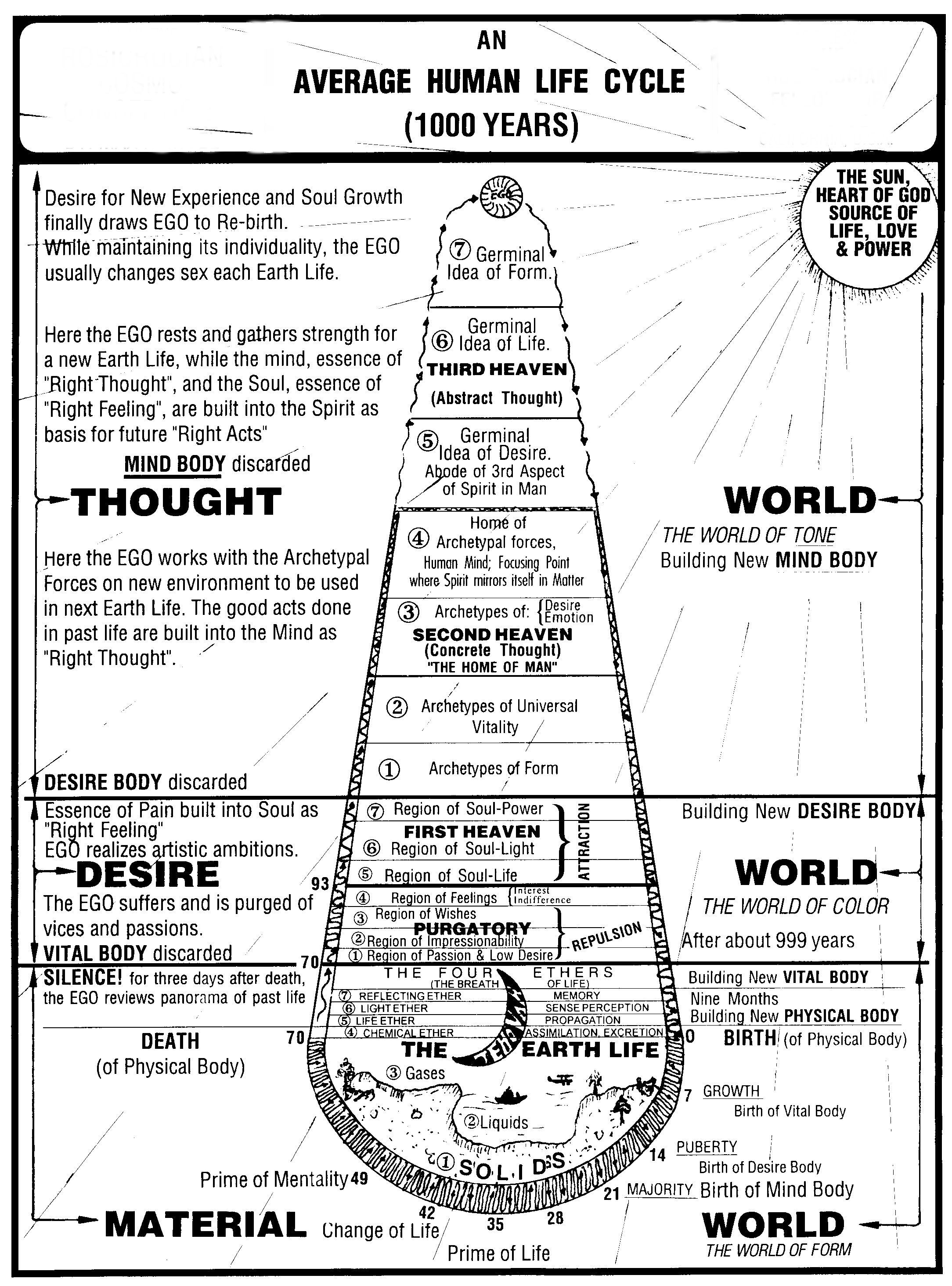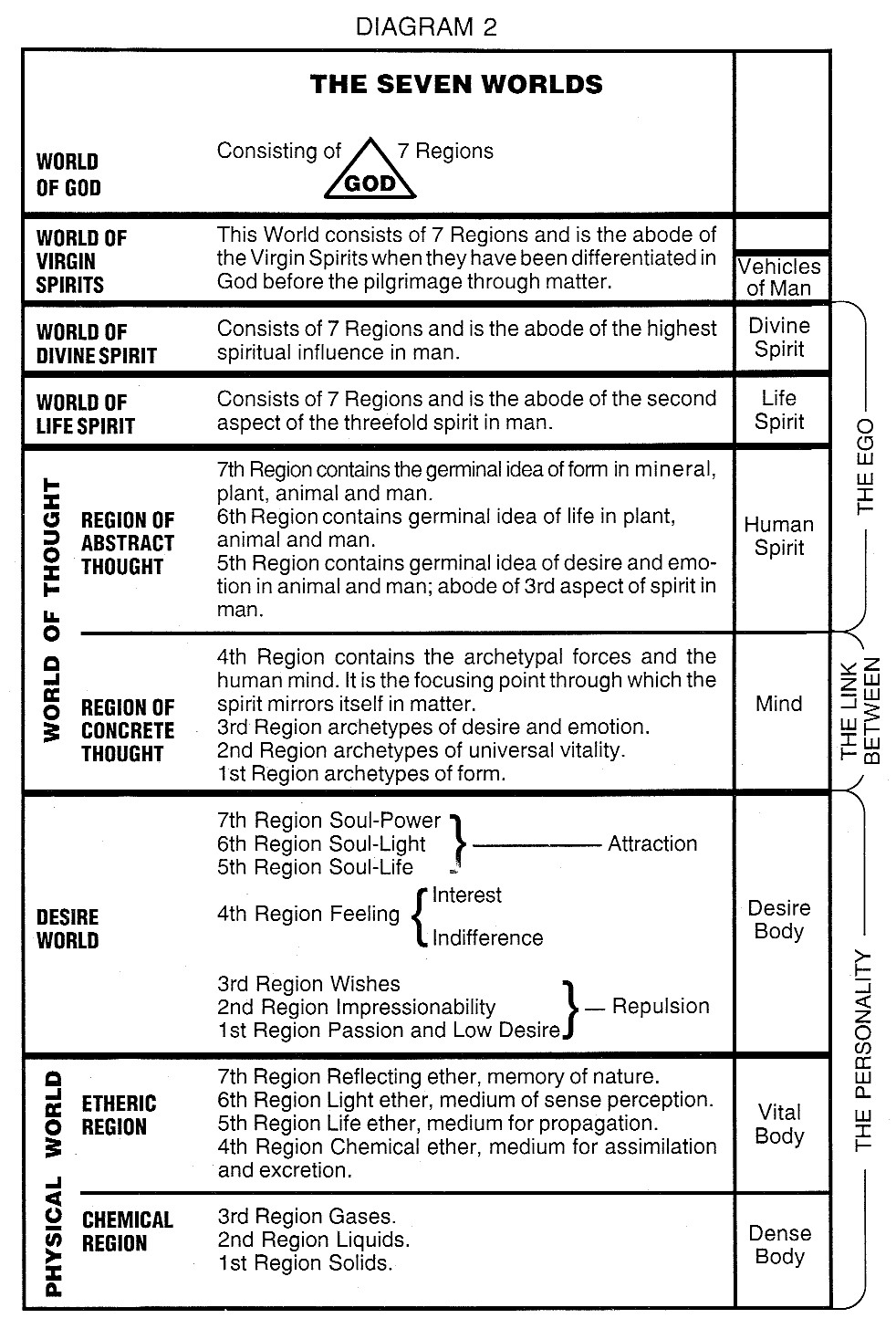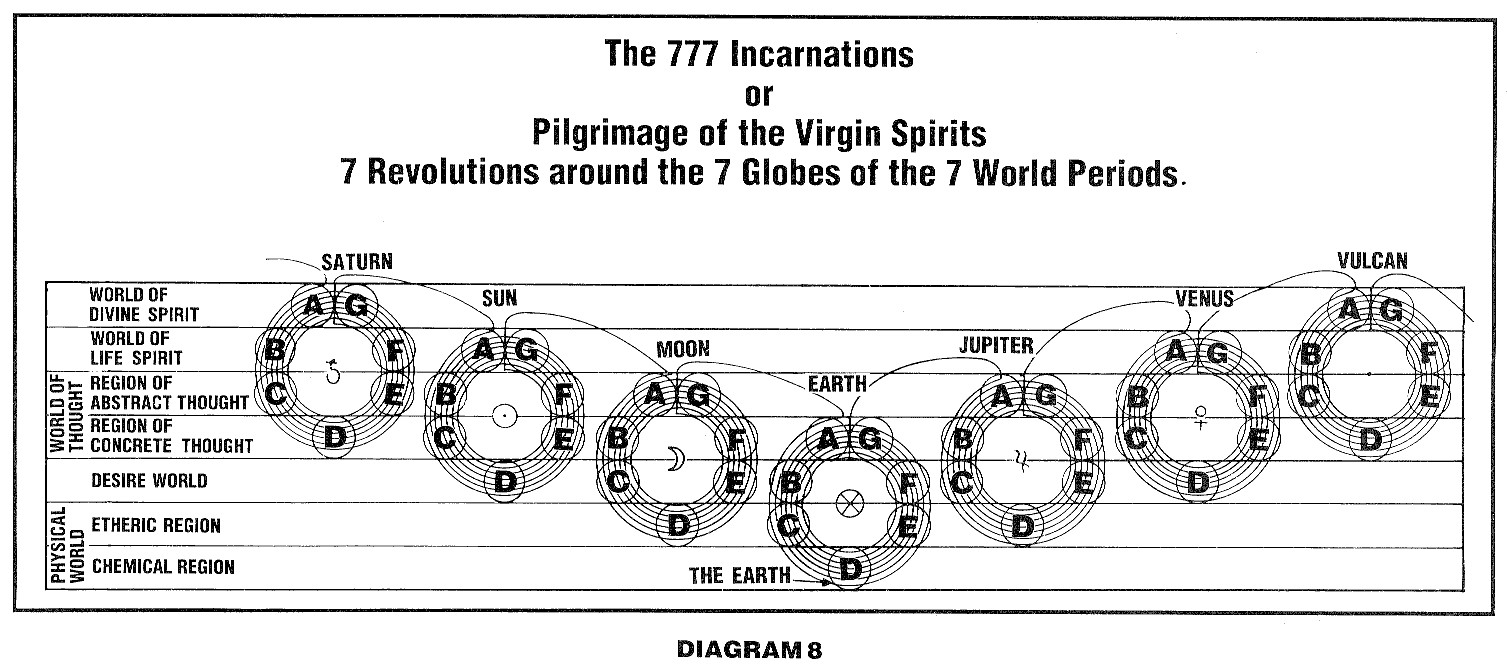
| RosicrucianU.com | ||
| Simplified Scientific Christianity |

By religion as well as by blood were the ancestors of the Persians intimately related to early post-Atlantean, Fifth Epoch peoples who settled in India. The hymns of the Rig-Veda, most ancient of Hindu Scriptures, and the Gathas, sacred songs of Persia, praise the same gods. Both religions centered primarily in the worship of a masculine deity; consequently, fire rather than water was the element sacred to both. A sacred drink which induced marvelous supernatural powers was common to both, the name itself showing a derivation from a common root: Soma in India and Haoma in Persia.
However, despite certain basic similarities due to their common origin, the two religions were widely different. The philosophy of India was dreamy, speculative, introspective. The philosophy of Persia was positive and aggressive. The ideal of the Persian aspirant was not to become a hermit whose keyword was renunciation, but to be a successful farmer and herdsman, a good father and a reputable citizen. In short, the Persian ideal was closer to the practical good men of Confucianism than to the contemplative saint of Hinduism. The former's good life consisted of strenuous activity in the services of God and man. It was a life in which normal social relationships could be brought to their highest fruition in peace, harmony and plenty for body and spirit.
The Avesta, or Law of Revelation, is the Scripture given to mankind by Zoroaster (Zoroaster is the popular Greek form of the name which is also spelled Zarathustra and Zardasht). Living as he did in the sixth century B. C., he was part of that great wave of spiritual light which swept around the globe, bringing Buddha to India, Lao-Tsu and Confucius to China, Pythagoras to Greece, Ezekiel to the Hebrews. It was a period which saw several great Bibles appear for the first time, among them the Hebrew Old Testament. Three of the most advanced Zoroastrian priests, still known as Magi in the ancient manner, followed the Star which guided them to the world's most sacred shrine in the little town of Bethlehem.
There now remains in Persia only a few small and scattered groups of Zoroastrians, the sacred fire shrines having been closed, one after another, as Islam won the allegiance of the people. This can be considered as naught but the action of the Law of Cause and Effect — for when Mani, the great Christed Messenger, came to the Zoroastrian priesthood preaching Christ as foretold by Zoroaster, they crucified him. They thus attracted to themselves the same fate which overtook the Hebrew priesthood less than three centuries earlier. They, like the Judean priests, rejected the Christ, and about three centuries later Mohammed, as agent of the Lords of Destiny, meted out to them their karmic harvest. Only a few remained faithful. Some of these, driven from their own land, found a congenial home in India and established what continues to be the only influential Zoroastrian (Parsi) community in the world today. This community lies adjacent to the city of Bombay.
Zoroaster — who was, according to Parsi tradition, a Mede — retained all that was supremely good in the old religion and lifted it beyond the limitation of time into the realm of the eternal. He extracted eternal from temporal truths, separating the universal truths applying to all mankind from the mass of folk lore and legend which had local application only. The Zoroastrian religion came at the very peak of the Arian Age and was one of the purest of the Shepherd religions, for it was built upon the foundation of all that had gone before. It named Ahura Mazda (Glory Light) as the Supreme Being; hence Mazdaism, another name for this religion. The Priests of the Medes were called Magi, a title meaning The Wise or Wonder-worker. Zoroaster retained it and centered his reformed religion in Mithra as Christianity centers in Christ.
The mysteries of Mithra were pivotal to the initiatory School of Iran. It was a profoundly secret cult, the crucifixion and resurrection constituting its innermost Mysteries.
Examples might be multiplied illustrative of the striking similarity between Persian and Christian Scriptures, but a few must suffice. The legend of creation in the Zend Avesta is almost identical with that of Genesis, and the stories of the Deluge and the War in Heaven are very similar. The Persian Scriptures contain, moreover, an almost exact duplicate of the Book of Jonah. This gives a cryptographic account of pre-Christian initiatory Rites and was used in all Mystery Schools of the time. Zoroaster's Enlightenment upon the Mountain which burned with fire but was not consumed is a parallel of Moses' Enlightenment on Sinai, while the later's vision of the burning bush finds a counterpart in the following: "The earth is all enchanted ground. Look on yon bush flaming with roses; listen, and if thy soul be not deaf, thou wilt hear the voice of God speaking to thee out of that bush." Esdras, the Hebrew Initiate, also had this experience in the Field of Ardath before he led his band of exiles back to Jerusalem. There are also a number of parallels between incidents in the life of Zoroaster and those in the lives of both Daniel and Joseph. For an interesting account of the close approximation of Zoroastrian teaching with that of Christianity, see Esoteric Tradition, by Dr. G. de Purucker.
Many supernatural incidents are related in legend about the person of a Christed Messenger, and these are abundant in the case of Zoroaster. It is related that when in heaven before his birth he was the equal in spiritual excellence of the Archangels. Similarly, Hebrew Kabbalists say that Elijah is, in spiritual essence, identifiable with the Archangel Sandallphon and Melchizadek with the Archangel Michael. Zoroaster's Guardian Spirit and own Higher Self, legends state, were before his birth marvelously combined with the "awful kingly Glory made by Mazda" — which belongs to the Archangels and "to the blessed Ones born and not yet born, who are to perform the restoration of the world." Zoroaster foresaw the coming Embodiment of Mithra (Christ) at the end of the Arian age, Him to whom that Glory should cleave, and instructed his followers to "live the life" which would prepare them for His appearance. One prophecy attributed to Zoroaster was that the Sun Being would come when a new star appeared in the constellation Virgo. According to Chinese chronicles a new star did appear in the heavens about the time Jesus of Nazareth was born, but its position relative to the Zodiac is not stated.
There are skeptics who deny that the Wise Men of Persia could have foreseen the coming of the Messiah, and particularly that they should have seen Him appearing in a foreign nation. Quite aside from powers of clairvoyance which see into the future, the Persians inherited from Chaldea a highly developed science of prediction by means of astrology. In her valuable book, Astrology: Its History and Influence, Ellen McCaffery, M.A., tells of a Persian astrologer, El Hakim or Gjamasp, whose work has come down through the Arabs. In the time of Hystaspia, he wrote a book called Judicia Gjamaspia in which he told of the conjunctions of Jupiter and Saturn and their effect on world history, prophesying the date of Christ's coming, the abolishment of the Magian religion, and the rise of Mohammedanisml So it is evident that coming events were foreseen by Persian Seers.
The Lord of Light, whose coming was thus prophesied, is no vaguely outlined figure dimly seen. He is a living Reality which could be known and experienced in the Mysteries. When, with spiritual vision, Zoroaster looked to the Sun and beheld the archangelic Christ indwelling that solar orb, he saw nothing, experienced nothing which had not been known for many thousands of years. His task was to clear away deadwood accumulated with the centuries, so that the Light of Truth might shine into the human soul.
According to legend, Zoroaster's training for his divine mission began before his birth, while he was yet dwelling with Angels in heaven. This is true of all great Teachers. He was prepared prior to his descent to earth through angelic and archangelic instruction; hence, the many references to celestial Beings in relation to his prenatal experiences. And preparation was made on earth for his coming. The maiden chosen by the Lords of Destiny to be his mother was surrounded and accompanied by a divine glory from birth. From early childhood she was continuously the center of so much supernatural phenomena that neighbors accused her of witchcraft and her father was compelled to send her to another village for safekeeping. The family into whose care she was entrusted included a young son, who became her husband.
The story of the immaculate conception and holy birth of Zoroaster is a very beautiful one. It is said that on the day after their marriage the bridegroom went down beside a river, where he saw growing out of the top of a tree a bright golden branch of Haoma — the plant from which the Persian sacred drink was made, its golden color being symbolic of Solar Essence. The young couple partook of the sacred drink together and the divine conception followed. The holy child was born laughing, so it was predicted by the Wise Men that his should be an illustrious career.
There are always many keys to the profound truths hidden in legends about Illumined Ones. For example, it was said that Zoroaster's birth was prophesied three thousand years previously by an ox miraculously gifted with human speech. Three thousand years before Zoroaster the Sun was, by precession, in the constellation Taurus which opened the solar year, and the symbol of this constellation is the ox or bun. Hence, it can be seen that what is really meant is that certain Wise Men of the Taurean Age foresaw the coming of Zoroaster and foretold his birth. This is entirely in harmony with what has been said about the Cycles of the Ages, with their attendant Teachers and Scriptures. As the Koran puts it: "For every Age its Book."
In Zoroaster's life, as in that of other World Teachers, the awakening age of adolescence was a time of revelation, for then there was a definite acceleration of consciousness in the case of this precocious child. At this critical period Zoroaster's life was marked by the division of his father's property between his brothers and himself, when he would accept only a girdle as his portion. The girdle, mystically considered, has reference to the aureole of light engirdling the entire body of such an advanced soul as Zoroaster.
It is not unusual for adolescent children to show unmistakable signs of spiritual gifts and inclinations. The boy Jesus revealed his spiritual genius at the age of twelve. Mani began teaching while still a child, but was restrained by his father so that his career properly began at the age of twenty-five or thirty. Zoroaster's acceptance of the girdle denotes his dedication at the early age of fourteen to the spiritual life.
Shortly after this he took the vows of silence for seven years. Pliny states that for twenty years he lived on cheese and in the barren places of the desert. The Zoroastrian Scriptures record that at the age of twenty he left home and sought the company of certain righteous men, and with them he ministered to the poor. Charitable activities and regard for the welfare of animals are two of the outstanding precepts of Zoroastrianism which find a close parallel in Christianity.
The great and decisive spiritual experience of Zoroaster's life came when he was thirty years of age. It is said he was carrying Haoma water when he suddenly found himself in the presence of the Archangel Vohu Meno (Good Mind), In other words, by partaking of this holy water of life his consciousness was so lifted up and expanded that he was able to commune with an exalted archangelic Being who evidently became his Teacher. The Archangel "Good Mind" obviously correlated with the planet Mercury, known in Chaldea as the God Nabu, and in the Hebrew Kabbala as Raphael. In the terminology of esoteric Christianity he is known as the Elder Brother from Mercury. Under the tutelage of this Archangel Zoroaster was prepared for that sublime experience which has been the goal of disciples since the first Mystery School was founded upon earth: to stand in the presence of the Supreme Lord of Love, to see Him face to face and to hear Him say: "Well done, thou good and faithful servant ... enter thou into the joy of thy lord."
It is further related that when the bright messenger of God questioned Zoroaster as to his chief desire, he replied: "To the wicked would that I could be in very truth a strong tormenter and avenger; but to the righteous may I be a mighty help and joy, since to preparations for Thy Kingdom and in desire for its approach I would devote myself so as to thee, O Mazda (Light), I may give praise and weave my song."
Upon hearing these words, Vahu. Meno brought Zoroaster into the presence of the Divine Ruler of all the realms of Truth, Light and Righteousness — the Sun behind the Sun.
Thus, simply and in few words, is described the great Solar Initiation awaiting all men. St. Paul said it was no longer seeing through a glass darkly, but face to face.
This great Initiation was the last stage of preparation for the Persian Master. His preaching became so rich with divine fire that people came to him by the thousands. As invariably occurs in such cases, the priesthood resented the new prophet, and his life was imperiled by the anger and jealousy of such as were loath to yield up their power.
Not easily, therefore, was victory won. Zoroaster suffered many disappointments and much treachery until, in his forty-second year, he went to the court of King Vishtashpa where, in debate, he vanquished the whole array of wise men attendant upon the throne. These priests represented the outgrown doctrines of the old order. To avenge themselves they placed various articles of black magic in Zoroaster's chamber, causing him to be imprisoned for sorcery. However, while in prison he effected the cure of the King's favorite horse. This so impressed the monarch that he freed Zoroaster and, together with all his household, embraced the new faith. The court followed where he led. Soon the cult of Zoroastrianism became the state religion.
Zoroaster spent the remainder of his life teaching and establishing Fire-Temples, for his Initiation pivoted around Initiation by Fire. This is not to say that the other three Initiations were unknown or were omitted from the Persian Mysteries, but it means that the work of Persia was centered in the spiritual element of Fire as symbolic of the Christ Love and Light of the Spiritual Sun.
It is said that Zoroaster was slain before one of his own altars by priests of the old regime who had feared and hated him since the early years of his coming., His death, according to some authorities, was in 583 B.C., only three years after Nebuchadnezzar captured Jerusalem and carried the Southern Kingdom of Judah into the seventy-year Babylonian captivity. He is, however, more often placed as contemporary with Cyrus and Darius. Hebrews serving at the court of Cyrus and succeeding monarchs of the Persian Empire were undoubtedly deeply affected by the purity and idealism of Zoroaster's monotheistic religion.
Trials by Fire, the central feature of Fire Initiation, are exemplified in the Book of Daniel where the King's interest in his Hebrew protégées: is very plainly shown; also, in the apocryphal, Book of Esdras, where it is openly stated that Cyrus worshipped the God of the Hebrews — that is, he held the same concept of Deity as did the Hebrew prophets of the Exile. The legend of the crucifixion of Cyrus descends from an esoteric source, for the Crucifixion Rite is part of initiatory work belonging to the Fire or Solar Initiation. Apropos of this, Gibil, the Fire God of Chaldea, was called "he who purifies the works of man." He stood in the place of the Sun when the Sun was absent during the hours of the night, so he was also the god of magic and sorcery. In the Solar Initiation of Persia the old legend was given a new application as Purification by Fire.
It is known to the Seer that the ardor of an aspiring soul appears in the form of living fire; hence, the terms "diamond soul" and "ruby soul" apply to the mystic and occultist respectively. Holy legends of Iran record that when Zoroaster was slain before his own altar, the glorious spirit which was his true being arose into heaven from the mangled corpse, ascending in scintillating flames of fire to join his fire to that of the Most Blessed Lord of the Fire Celestial.
Thus, Zoroaster takes his place among Immortals as one of the flaming messengers of the Great Light — the Light that is One though called by many names.
Persia reached glorious heights of civilization under the impetus of Zoroastrianism, but this civilization was destroyed in its flower by the conquest of Alexander. With it was destroyed the beautiful city of Persepolis, the spiritual center of the nation.
In this fair land where delicious fruits were grown, where the nightingale sang sweetly and roses grew to the height of trees, Darius built the famous city of Persepolis with its magnificent palaces and beautiful Fire Temples. In the spacious halls of the latter priests seven times daily fed the sacred flames with logs of fragrant sandalwood. So sacred were those fires that the attending priests always went veiled before them lest their countenances pollute the holy fire.
Many inscriptions on the broken columns of the far-reaching ruins have been deciphered as dedications to the Zoroastrian Fire God. Some of these inscriptions are as follows: "Artexerxes the king has declared that this great work is done by men. May Ahura-Mazda and Mithra. protect me, my building and my people," "Xerxes, the King of Kings and successor of the ruler of the world;" "Ahura-Mazda (Ormazd) is a mighty god who has created heaven and earth and who has given glory to men; who has made Xerxes King and the ruler of many. I, Xerxes, King of Kings, son of Darius and King of the earth near and far. What I have done here and what I have done elsewhere I have done by the grace of Abura-Mazda."
Quintus Curtius (64 B.C.) in describing the army of Darius, wrote: "The fire which they called Eternal was carried before them on silver altars; the Magi came after it, singing hymns in the Persian manner. Three hundred and sixty-five youths clothed in scarlet followed them, according to the number of days in the year as the Persians compute it. He also describes Darius as conjuring his soldiers by the Eternal Fire and the shining of the Sun.
Darius erected many Temples to the Great Light and to Mithra, the Sun God whose golden rays, said the Magi, emanated a powerful elixir (like the Haoma drink) which had power to change base metals into gold.
Herodotus bad much to say regarding the manners and customs of the Magi. "They have," he wrote, "no altars or images, but worship God on the mountain top. They adore the heavens and offer sacrifice to the Sun, Moon, earth, fire, water and winds."
Plutarch has given a brief but accurate discussion of the Zoroastrian philosophy: "Some believe there are two gods, one the maker of good things and the other of bad. Some call the better of these God, and the other Daemon, as doth Zoroaster, the Magi. Zoroaster called one of these Oromazdes (Ahura-Mazda) and the other Abrimanius (Ahriman) and affirmed that one of them did most resemble light and the other darkness; but that Mithras was in the middle between them. For which cause the Persians call Mithras the Mediator. And they tell us that he first taught mankind to make offerings and vows of thanksgiving to the one and to offer averting and feral sacrifice to the other. They affirm that Oromazda springeth from the purest light and Abrimanius from deepest darkness, and that therefore there is constant warfare between them. Oromazda created six Gods of Light to attend upon him; the first was the author of Benevolence, the second of Truth, the third of justice, the fourth of Wisdom, the fifth of Wealth, and the sixth of that high pleasure which accrues from good actions. Then it was that Abrimanius made a similar number of opposing Gods of Darkness with the opposite characteristics with which to counteract the operations of the God of Light."
Thus was introduced the two opposing principles of good and evil. Every follower of Zoroaster was exhorted to become a warrior fighting on the side of Light against Darkness. It is not too difficult to see how this holy doctrine, misinterpreted by narrow minds, could lead to the intolerance which cast a shadow on Zoroastrianism by the end of the age.
— Corinne Heline

|

|

|
|
|
Contemporary Mystic Christianity |
|
|
This web page has been edited and/or excerpted from reference material, has been modified from its original version, and is in conformance with the web host's Members Terms & Conditions. This website is offered to the public by students of The Rosicrucian Teachings, and has no official affiliation with any organization. | Mobile Version | |
|